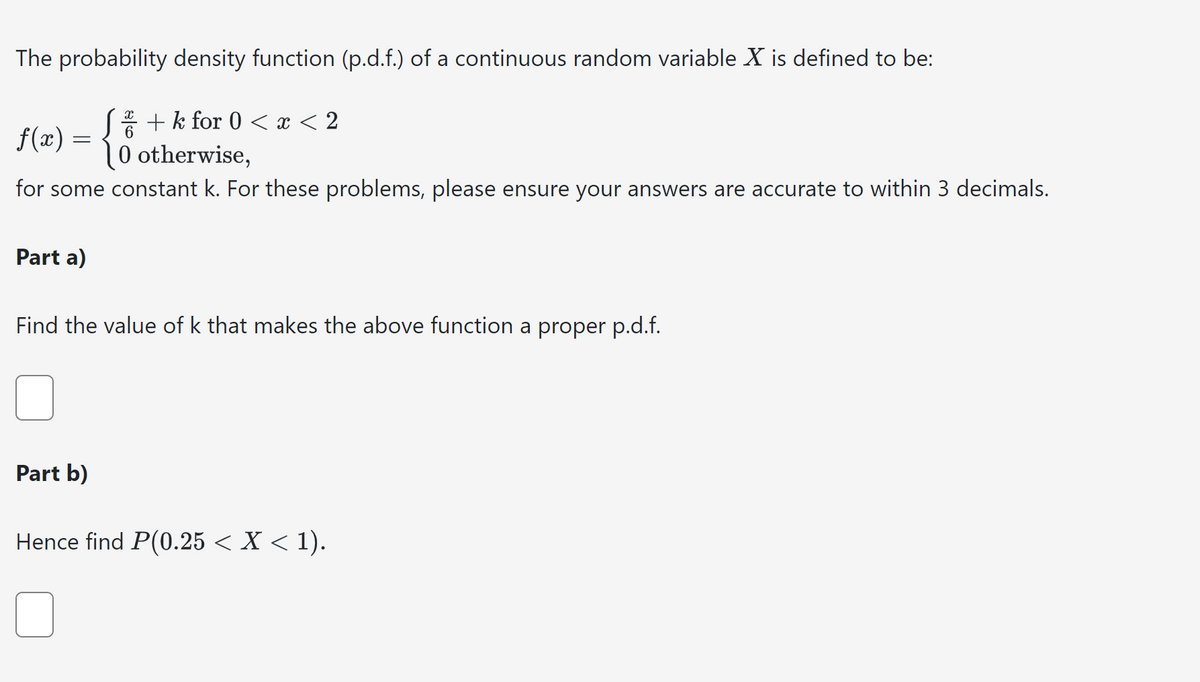The probability density function (p.d.f.) of a continuous random variable X is defined to be: x ( + k for 0 < x < 2 f(x) = {{ 0 otherwise, for some constant k. For these problems, please ensure your answers are accurate to within 3 decimals. Part a) Find the value of k that makes the above function a proper p.d.f. Part b) Hence find P(0.25 < x < 1).
The probability density function (p.d.f.) of a continuous random variable X is defined to be: x ( + k for 0 < x < 2 f(x) = {{ 0 otherwise, for some constant k. For these problems, please ensure your answers are accurate to within 3 decimals. Part a) Find the value of k that makes the above function a proper p.d.f. Part b) Hence find P(0.25 < x < 1).
Algebra and Trigonometry (MindTap Course List)
4th Edition
ISBN:9781305071742
Author:James Stewart, Lothar Redlin, Saleem Watson
Publisher:James Stewart, Lothar Redlin, Saleem Watson
Chapter14: Counting And Probability
Section14.2: Probability
Problem 3E: The conditional probability of E given that F occurs is P(EF)=___________. So in rolling a die the...
Related questions
Question

Transcribed Image Text:The probability density function (p.d.f.) of a continuous random variable X is defined to be:
x
( + k for 0 < x < 2
f(x) = {{
0 otherwise,
for some constant k. For these problems, please ensure your answers are accurate to within 3 decimals.
Part a)
Find the value of k that makes the above function a proper p.d.f.
Part b)
Hence find P(0.25 < x < 1).
Expert Solution
This question has been solved!
Explore an expertly crafted, step-by-step solution for a thorough understanding of key concepts.
This is a popular solution!
Trending now
This is a popular solution!
Step by step
Solved in 2 steps

Recommended textbooks for you

Algebra and Trigonometry (MindTap Course List)
Algebra
ISBN:
9781305071742
Author:
James Stewart, Lothar Redlin, Saleem Watson
Publisher:
Cengage Learning

Glencoe Algebra 1, Student Edition, 9780079039897…
Algebra
ISBN:
9780079039897
Author:
Carter
Publisher:
McGraw Hill

Algebra & Trigonometry with Analytic Geometry
Algebra
ISBN:
9781133382119
Author:
Swokowski
Publisher:
Cengage

Algebra and Trigonometry (MindTap Course List)
Algebra
ISBN:
9781305071742
Author:
James Stewart, Lothar Redlin, Saleem Watson
Publisher:
Cengage Learning

Glencoe Algebra 1, Student Edition, 9780079039897…
Algebra
ISBN:
9780079039897
Author:
Carter
Publisher:
McGraw Hill

Algebra & Trigonometry with Analytic Geometry
Algebra
ISBN:
9781133382119
Author:
Swokowski
Publisher:
Cengage